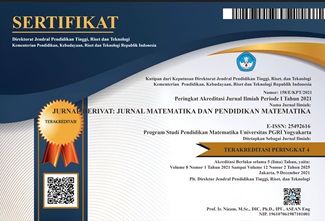Model Stokastik Pada Penyebaran Penyakit Tuberkulosis
DOI:
https://doi.org/10.31316/jderivat.v10i2.5573Abstract
Tuberculosis is an infectious disease caused by Mycobacterium tuberculosis. This disease represents a significant global public health challenge. Consequently, a stochastic differential equation model of tuberculosis has been developed. In this context, an analysis examines the impact of complete treatment on the disease-free population distribution, duration of disease-free status, and the probability of remaining disease-free. The analysis shows that as the rate of complete treatment increases, the probability of achieving disease-free status rises, the duration of remaining disease-free shortens, and the number of disease-free individuals grows over time.
Keywords: Complete Treatment, Disease-Free Duration, Stochastic Differential Equations, Tuberculosis
References
Allen, LJS. 2010. An Introduction to Stochastic Processes with Aplications to Biology. Second.
Crofton, John, Norman Horne, and Fred Miller. 2009. Crofton’s Clinical Tuberculosis.
Chandra, TD, and Roudhotillah D. 2021. Analisis Kestabilan Model Penyebaran Penyakit Tuberkulosis dengan Menggunakan Mseitr. Wahana Matematika dan Sains 15(2): 56-74.
Currie, Christine S. M., Katherine Floyd, Brian G. Williams, and Christopher Dye. 2005. “Cost, Affordability and Cost-Effectiveness of Strategies to Control Tuberculosis in Countries with High HIV Prevalence.” BMC Public Health 5(March 2017). doi: 10.1186/1471-2458-5-130.
Mathofani, P. E., and Febriyanti, R. 2020. Faktor-Faktor Yang Berhubungan Dengan Kejadian Penyakit Tuberkulosis (Tb) Paru Di Wilayah Kerja Puskesmas Serang Kota Tahun 2019. 12(1): 1-10.
Nurhana, ID. 2023. Analisis Kestabilan Model SVIQR pada Penyebaran Penyakit Difteri dengan Pengaruh Vaksinasi dan Karantina. 11(02): 265-273.
Van Den Driessche, P., and James Watmough. 2002. “Reproduction Numbers and Sub-Threshold Endemic Equilibria for Compartmental Models of Disease Transmission.” Mathematical Biosciences 180(1–2):29–48. doi: 10.1016/S0025-5564(02)00108-6.
Mode, CJ, and CK Sleeman. 2000. Stochastic Processes in Epidemiology.
Ozcaglar, Cagri, Amina Shabbeer, Scott L. Vandenberg, Bülent Yener, and Kristin P. Bennett. 2012. “Epidemiological Models of Mycobacterium Tuberculosis Complex Infections.” Mathematical Biosciences 236(2):77–96. doi: 10.1016/j.mbs.2012.02.003.
Song, Baojun, Carlos Castillo-Chavez, and Juan Pablo Aparicio. 2002. “Tuberculosis Models with Fast and Slow Dynamics: The Role of Close and Casual Contacts.” Mathematical Biosciences 180(1–2):187–205. doi: 10.1016/S0025-5564(02)00112-8.
Downloads
Published
Issue
Section
Citation Check
License
Copyright (c) 2024 Nur Aziezah

This work is licensed under a Creative Commons Attribution-ShareAlike 4.0 International License.
Authors who publish with this journal agree to the following terms:
-
Authors retain copyright and grant the journal right of first publication with the work simultaneously licensed under a Creative Commons Attribution-ShareAlike 4.0 International License that allows others to share the work with an acknowledgment of the work's authorship and initial publication in this journal.
- Authors are able to enter into separate, additional contractual arrangements for the non-exclusive distribution of the journal's published version of the work (e.g., post it to an institutional repository or publish it in a book), with an acknowledgment of its initial publication in this journal.
- Authors are permitted and encouraged to post their work online (e.g., in institutional repositories or on their website) prior to and during the submission process, as it can lead to productive exchanges, as well as earlier and greater citation of published work (See The Effect of Open Access).







